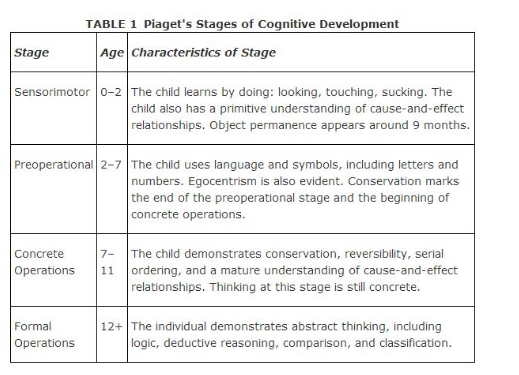Piaget's Model of Cognitive Development
Much of modern cognitive theory, including its relationship to socialization, stems from the work of the Swiss psychologist, Jean Piaget.
In the 1920s Piaget observed children reasoning and understanding differently, depending on their age.
He proposed that all children progress through a series of cognitive stages of development, just as they progress through a series of physical stages of development.
According to Piaget, the rate at which children pass through these cognitive stages may vary, but they eventually pass through all of them in the same order.
Piaget introduced several other important concepts.
According to Piaget, cognitive development occurs from two processes: adaptation and equilibrium.
Adaptation involves the child's changing to meet situational demands.
Adaptation involves two sub‐processes: assimilation and accommodation.
Assimilation is the application of previous concepts to new concepts.
An example is the child who refers to a whale as a “fish.” Accommodation is the altering of previous concepts in the face of new information.
An example is the child who discovers that some creatures living in the ocean are not fish, and then correctly refers to a whale as a “mammal.” Equilibrium is the search for “balance” between self and the world, and involves the matching of the child's adaptive functioning to situational demands.
Equilibrium keeps the infant moving along the developmental pathway, allowing him or her to make increasingly effective adaptations.
A brief summary of Piaget's four stages of cognitive development appears in Table 1.

Join in and write your own page! It's easy to do. How? Simply click here to return to Sociology FAQ.
Scholarship 2025/26
Current Scholarships 2025/2026 - Fully Funded
Full Undergraduate Scholarships 2025 - 2026
Fully Funded Masters Scholarships 2025 - 26
PhD Scholarships for International Students - Fully Funded!
Funding Opportunities for Journalists 2025/2026
Funding for Entrepreneurs 2025/2026
***
